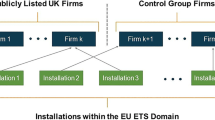Abstract
This paper examines the effect of antidumping duties on the restructuring activities of protected plants. Using a dataset that contains the full population of U.S. manufacturers, I find that protected plants increase their capital intensities modestly relative to unprotected plants, but only when antidumping duties have been in place for a sufficient duration. I find little effect of antidumping duties on a proxy for the skilled labor intensity of protected plants.
Similar content being viewed by others
Notes
See Pierce and Schott (2012) for more details.
See Bown (2012).
The table reports means and standard deviations for all continuous variables that are employed in this paper. The Census Bureau does not permit release of minimum and maximum data, as they represent survey responses of individual establishments. Review of minimum and maximum data by the author did not reveal any anomalous observations.
In the time period examined in this paper, five of the 148 antidumping investigations completed ended with suspension agreements as the only form of protection. Under this arrangement, foreign firms agree to stop dumping, in exchange for suspension of the antidumping investigation. Because data on the effective duty rate—considered later in the paper—are unavailable for these investigations, they have been excluded from this analysis.
These two sources of bias were first discussed in Konings and Vandenbussche (2008).
The level of the Dur variable, as well as its interactions with Treatment and Post, individually, are not in the specification as they cannot be separately identified from the other covariates and fixed effects.
Note that the reported standard errors are adjusted to control for clustering at the product level.
See, e.g., Dixit and Pindyck (1994).
See Becker and Gray (2009).
References
Becker, R., & Gray, W. (2009). NBER-CES manufacturing industry database. Available online at http://www.nber.org/data/nbprod2005.html.
Berman, E., Bound, J., & Griliches, Z. (1994). Changes in the demand for skilled labor within U.S. manufacturing: Evidence from the annual survey of manufactures. Quarterly Journal of Economics, 109(2), 367–397.
Bernard, A., & Jensen, J. B. (1997). Exporters, skill upgrading and the wage gap. Journal of International Economics, 42(1–2), 3–31.
Bernard, A., Jensen, J. B., & Schott, P. (2006). Survival of the best fit: Exposure to low-wage countries and the (uneven) growth of U.S. manufacturing. Journal of International Economics, 68(1), 219–237.
Blonigen, B., & Park, J. (2004). Dynamic pricing in the presence of antidumping policy: Theory and evidence. American Economic Review, 94(1), 134–154.
Bown, C. (2012). Global antidumping database. The World Bank. Available online at http://econ.worldbank.org/ttbd/gad/.
Crowley, M. (2006). Do antidumping duties and safeguard tariffs open or close technology gaps? Journal of International Economics, 68(2), 469–484.
Dixit, A., & Pindyck, R. (1994). Investment under uncertainty. Princeton: Princeton University Press.
Konings, J., & Vandenbussche, H. (2008). Heterogeneous responses to trade protection. Journal of International Economics, 76(2), 371–383.
Matsuyama, K. (1990). Perfect equilibria in a trade liberalization game. American Economic Review, 80(3), 480–492.
Miyagiwa, K., & Ohno, Y. (1995). Closing the technology gap under protection. American Economic Review, 85(4), 755–770.
Pierce, J. (2011). Plant-level responses to antidumping duties: Evidence from U.S. manufacturers. Journal of International Economics, 85(2), 222–233.
Pierce, J., & Schott, P. (2012). A concordance between U.S. Harmonized system codes and SIC/NAICS product classes and industries. Journal of Economic and Social Measurement, 37(1–2), 53–68.
U.S. International Trade Commission. (2006). Import injury investigations: Case statistics: FY 1980–2005.
Acknowledgments
I thank Bob Feinberg and Larry White for helpful comments. All remaining errors are my own.
Author information
Authors and Affiliations
Corresponding author
Rights and permissions
About this article
Cite this article
Pierce, J.R. Antidumping Duties and Plant-Level Restructuring. Rev Ind Organ 42, 435–447 (2013). https://doi.org/10.1007/s11151-013-9386-8
Published:
Issue Date:
DOI: https://doi.org/10.1007/s11151-013-9386-8




